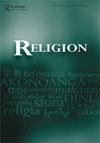离开宗教手册
IF 0.9
2区 哲学
0 RELIGION
引用次数: 0
摘要
它对当地宗教生活的权威?(35)。第四,在塑造个人宗教观方面,现代沟通方式是否比传统方式更有效?有没有一种更有效的方法来描绘“非精英”个人的宗教世界及其对现代性的反应?还是更简单地将它们定位在宏观叙事中(如第一章和第二章所述)?总之,当读者自己打开这本书的时候,他们会发现更多有趣的想法和灵感,因为我们在这里的总结和评论绝不是全面的。除了是对区域宗教及其理论范式的优秀研究之外,它考虑了社区,知识和宗教信仰框架内的宗教变化和重构,这本书无疑是该领域的一个里程碑,因为它既是对现代转型中的中国宗教的研究概述,也是进一步区域和比较研究的出发点。这部著作是任何研究中国近代宗教的学者,无论从事哪个分支领域的研究,都不可错过的。本文章由计算机程序翻译,如有差异,请以英文原文为准。
Handbook of Leaving Religion
its authority over local religious life’? (35). Fourth, are modern communication methods more effective in shaping individual religious views than traditional ones? Is there a more effective approach to depicting the religious world of ‘non-elite’ individuals and their response to modernity? Or is it still much simpler to locate them in a macro narrative (as presented in Chapters 1 and 2)? In sum, readers will only discover more fascinating ideas and find inspiration from the book when they open it for themselves, as our summary and comments here are by no means comprehensive. In addition to being an excellent study of regional religion and its theoretical paradigm, which takes into account religious changes and reconfigurations within the framework of community, knowledge, and religiosity, this volume is unquestionably a milestone in the field, as it serves both as a research overview of Chinese religions in modern transformation and a point of departure for further regional and comparative studies. This work is not to be missed by any scholars of modern Chinese religion, no matter which subfield they are devoted to.
求助全文
通过发布文献求助,成功后即可免费获取论文全文。
去求助
来源期刊

RELIGION
RELIGION-
CiteScore
2.70
自引率
0.00%
发文量
58
期刊介绍:
RELIGION is an internationally recognized peer-reviewed journal, publishing original scholarly research in the comparative and interdisciplinary study of religion. It is published four times annually: two regular issues; and two special issues (or forums) on focused topics, generally under the direction of guest editors. RELIGION is committed to the publication of significant, novel research, review symposia and responses, and survey articles of specific fields and national contributions to scholarship. In addition, the journal includes book reviews and discussions of important venues for the publication of scholarly work in the study of religion.
 求助内容:
求助内容: 应助结果提醒方式:
应助结果提醒方式:


